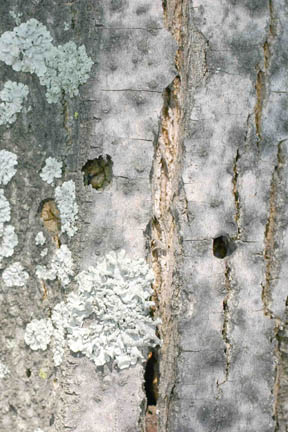Lilac or Ash Borer | |
|---|---|
| May 8, 2006 | |
Now is when that plants such as ash, lilac, and privet are prone to attack from the lilac or ash borer, Podosesia syringae. Adults are brown, clearwing moths that resemble paper wasps. Peak moth flight or activity occurs in late May to early June. Adult females lay oval, tan eggs in cracks, crevices, or wounds at the base of plant stems. A single mated female lives about one week and can lay up to 400 eggs. Lilac borer emergence holes Lilac borer emergence holesThe eggs of lilac or ash borer hatch into cream-colored larvae, about 1.5 inches long when full grown, with brown heads. Larvae cause plant injury by creating tunnels and feeding within the bark (cambium). The larvae bore further into the wood and feed within the sapwood and heartwood. Larval feeding restricts the flow of water and nutrients, causing shoot dieback. Lilac or ash borer typically feeds near the base of plant stems. As the larvae feed, they create swollen areas or cracks at the base of plants and where major branches attach to the trunk. Evidence of larval feeding is the light-colored sawdust below infected areas. Lilac or ash borer overwinters as late-instar larvae located in feeding tunnels. Lilac or ash borer larvae eventually partially tunnel out through the bark before pupating. The moth that emerges from the pupae is unable to chew, so it simply pushes out the thin layer of bark remaining. When the moth emerges, the brown pupa shell is usually left behind and protrudes from the hole. Sometimes this is barely visible, but commonly the pupa case extrudes out about inch. Male moths emerge first, with females emerging later. Moths are 1.0 inch long, with a brown-colored body, and are very active fliers. In Illinois, there is only one generation per year. As with most wood-boring insects, the primary means of managing or preventing problems with lilac or ash borer is to avoid plant “stress” by properly implementing cultural practices such as watering, fertility, pruning, and mulching. Stressed plants are much more susceptible to attack from lilac or ash borer than healthy plants. A 2-to-3-foot-wide mulched area around the base of trees and shrubs prevents injury from lawn mowers and weed-trimmers. In addition, avoid pruning plants in late spring through early summer, which is when moths are present. If necessary, the insecticide permethrin (Astro) can be applied to control lilac or ash borer larvae before they enter the plant. Pheromone traps are available that capture adult males, which indicates that females will eventually be laying eggs. This helps in timing insecticide applications. Check the traps two to three times per week and record the number of newly caught males. Spray 2 weeks after peak male capture. Another potential option is the use of entomopathogenic (= beneficial) nematodes. The nematodes are applied as a heavy spray or are injected into the larval entry points. Nematodes enter the entry points, search out, and attack larvae feeding within the tunnels. |